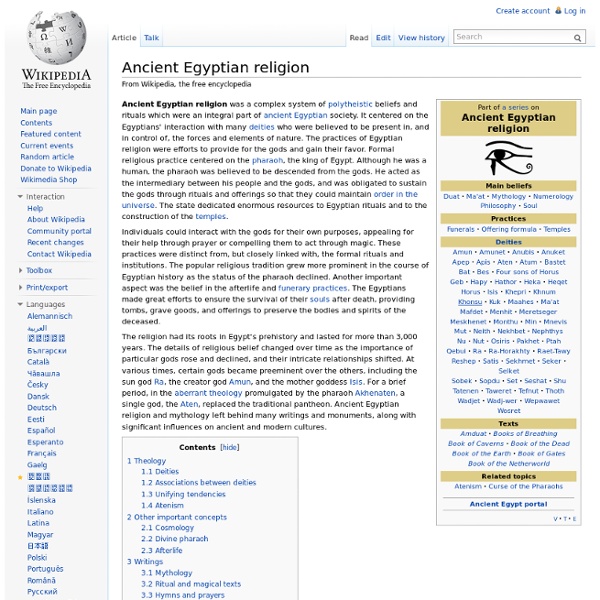Ancient Egyptian religion

Religion in Egypt
Religion in Egypt Religion in Egypt controls many aspects of social life and is endorsed by law. The state religion of Egypt is Islam. Although estimates vary greatly in the absence of official statistics. Egypt hosts two major religious institutions.[2] Al-Azhar Mosque, founded in AD 970 by the Fatimids as the first Islamic university in Egypt and the Coptic Orthodox Church of Alexandria established in the middle of the 1st century by Saint Mark. In 2002, under the Mubarak government, Coptic Christmas (January 7) was recognized as an official holiday,[4] though Christians complain of being minimally represented in law enforcement, state security and public office, and of being discriminated against in the workforce on the basis of their religion.[5][6] Demographics[edit] However, most Christians refuted these figures, claiming they have been under-counted. Freedom of religion and human rights[edit] Restrictions on conversion[edit] Relations with the Coptic minority[edit] Islam[edit]
Ancient Egypt
Egypt is a country in North Africa, on the Mediterranean Sea, and is among the oldest civilizations on earth. The name 'Egypt' comes from the Greek Aegyptos which was the Greek pronunciation of the Egyptian name 'Hwt-Ka-Ptah' (which means "House of the Spirit of Ptah", who was a very early God of the Ancient Egyptians). In the early Old Kingdom, Egypt was simply known as 'Kemet' which means 'Black Land' so named for the rich, dark soil along the Nile River where the first settlements began. Evidence of overgrazing of cattle, on the land which is now the Sahara Desert, has been dated to about 8,000 BCE. Prosperity led to, among other things, an increase in the brewing of beer, more leisure time for sports, and advances in medicine. Early History of Egypt The Early Dynastic Period (c. 3150-c. 2686 BCE) saw the unification of the north and south kingdoms of Egypt under the Pharaoh Manes (also known as Meni or Menes) of the south who conquered the north in 3118 BCE.
Ancient Egypt
Ancient Egypt was an ancient civilization of Northeastern Africa, concentrated along the lower reaches of the Nile River in what is now the modern country of Egypt. It is one of six civilizations globally to arise independently. Egyptian civilization coalesced around 3150 BC (according to conventional Egyptian chronology)[1] with the political unification of Upper and Lower Egypt under the first pharaoh.[2] The history of ancient Egypt occurred in a series of stable Kingdoms, separated by periods of relative instability known as Intermediate Periods: the Old Kingdom of the Early Bronze Age, the Middle Kingdom of the Middle Bronze Age and the New Kingdom of the Late Bronze Age. History Map of ancient Egypt, showing major cities and sites of the Dynastic period (c. 3150 BC to 30 BC) Predynastic period A typical Naqada II jar decorated with gazelles. In Predynastic and Early Dynastic times, the Egyptian climate was much less arid than it is today. Early Dynastic Period (c. 3050 –2686 BC)
The History of Halloween
Halloween is one of the world's oldest holidays, dating back to pagan times. But it is celebrated today by more people in more countries than ever before. there's a simple reason: it is fun and it is good, clean, harmless fun for young and old alike! Also see Halloween around the world and see this page of current Halloween facts and statistics. Since much of the history of Halloween wasn't written down for centuries; some of it is still sketchy and subject to debate. But the most plausible theory is that Halloween originated in the British Isles out of the Pagan Celtic celebration of Samhain. It goes back as far as 5 B.C. Many centuries later, the Roman Catholic church, in an attempt to do away with pagan holidays, such as Halloween (and Christmas, which had been the Roman pagan holiday of Saturnalia) established November 1st as All Saint's Day (in French, la Toussaint), in celebration of all the saints who do not have their own holy day.
Related:
Related:



